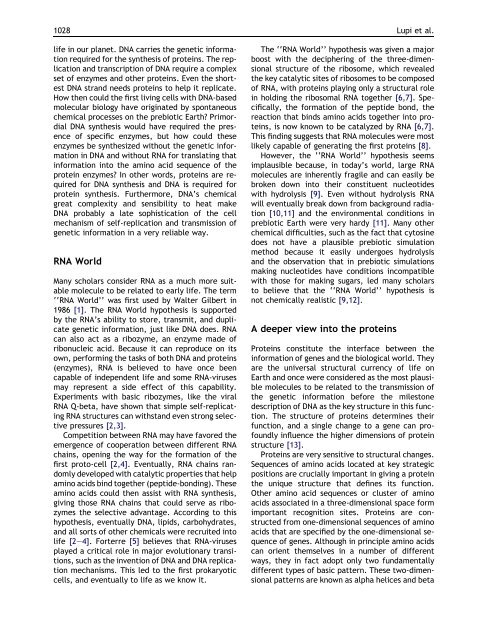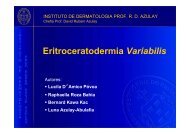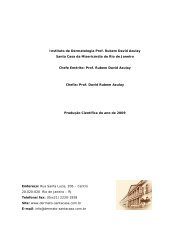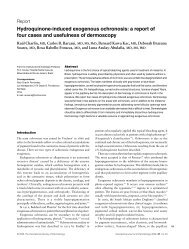Are prions related to the emergence of early life? - instituto de ...
Are prions related to the emergence of early life? - instituto de ...
Are prions related to the emergence of early life? - instituto de ...
Create successful ePaper yourself
Turn your PDF publications into a flip-book with our unique Google optimized e-Paper software.
1028 Lupi et al.<br />
<strong>life</strong> in our planet. DNA carries <strong>the</strong> genetic information<br />
required for <strong>the</strong> syn<strong>the</strong>sis <strong>of</strong> proteins. The replication<br />
and transcription <strong>of</strong> DNA require a complex<br />
set <strong>of</strong> enzymes and o<strong>the</strong>r proteins. Even <strong>the</strong> shortest<br />
DNA strand needs proteins <strong>to</strong> help it replicate.<br />
How <strong>the</strong>n could <strong>the</strong> first living cells with DNA-based<br />
molecular biology have originated by spontaneous<br />
chemical processes on <strong>the</strong> prebiotic Earth? Primordial<br />
DNA syn<strong>the</strong>sis would have required <strong>the</strong> presence<br />
<strong>of</strong> specific enzymes, but how could <strong>the</strong>se<br />
enzymes be syn<strong>the</strong>sized without <strong>the</strong> genetic information<br />
in DNA and without RNA for translating that<br />
information in<strong>to</strong> <strong>the</strong> amino acid sequence <strong>of</strong> <strong>the</strong><br />
protein enzymes? In o<strong>the</strong>r words, proteins are required<br />
for DNA syn<strong>the</strong>sis and DNA is required for<br />
protein syn<strong>the</strong>sis. Fur<strong>the</strong>rmore, DNA’s chemical<br />
great complexity and sensibility <strong>to</strong> heat make<br />
DNA probably a late sophistication <strong>of</strong> <strong>the</strong> cell<br />
mechanism <strong>of</strong> self-replication and transmission <strong>of</strong><br />
genetic information in a very reliable way.<br />
RNA World<br />
Many scholars consi<strong>de</strong>r RNA as a much more suitable<br />
molecule <strong>to</strong> be <strong>related</strong> <strong>to</strong> <strong>early</strong> <strong>life</strong>. The term<br />
‘‘RNA World’’ was first used by Walter Gilbert in<br />
1986 [1]. The RNA World hypo<strong>the</strong>sis is supported<br />
by <strong>the</strong> RNA’s ability <strong>to</strong> s<strong>to</strong>re, transmit, and duplicate<br />
genetic information, just like DNA does. RNA<br />
can also act as a ribozyme, an enzyme ma<strong>de</strong> <strong>of</strong><br />
ribonucleic acid. Because it can reproduce on its<br />
own, performing <strong>the</strong> tasks <strong>of</strong> both DNA and proteins<br />
(enzymes), RNA is believed <strong>to</strong> have once been<br />
capable <strong>of</strong> in<strong>de</strong>pen<strong>de</strong>nt <strong>life</strong> and some RNA-viruses<br />
may represent a si<strong>de</strong> effect <strong>of</strong> this capability.<br />
Experiments with basic ribozymes, like <strong>the</strong> viral<br />
RNA Q-beta, have shown that simple self-replicating<br />
RNA structures can withstand even strong selective<br />
pressures [2,3].<br />
Competition between RNA may have favored <strong>the</strong><br />
<strong>emergence</strong> <strong>of</strong> cooperation between different RNA<br />
chains, opening <strong>the</strong> way for <strong>the</strong> formation <strong>of</strong> <strong>the</strong><br />
first pro<strong>to</strong>-cell [2,4]. Eventually, RNA chains randomly<br />
<strong>de</strong>veloped with catalytic properties that help<br />
amino acids bind <strong>to</strong>ge<strong>the</strong>r (pepti<strong>de</strong>-bonding). These<br />
amino acids could <strong>the</strong>n assist with RNA syn<strong>the</strong>sis,<br />
giving those RNA chains that could serve as ribozymes<br />
<strong>the</strong> selective advantage. According <strong>to</strong> this<br />
hypo<strong>the</strong>sis, eventually DNA, lipids, carbohydrates,<br />
and all sorts <strong>of</strong> o<strong>the</strong>r chemicals were recruited in<strong>to</strong><br />
<strong>life</strong> [2–4]. Forterre [5] believes that RNA-viruses<br />
played a critical role in major evolutionary transitions,<br />
such as <strong>the</strong> invention <strong>of</strong> DNA and DNA replication<br />
mechanisms. This led <strong>to</strong> <strong>the</strong> first prokaryotic<br />
cells, and eventually <strong>to</strong> <strong>life</strong> as we know it.<br />
The ‘‘RNA World’’ hypo<strong>the</strong>sis was given a major<br />
boost with <strong>the</strong> <strong>de</strong>ciphering <strong>of</strong> <strong>the</strong> three-dimensional<br />
structure <strong>of</strong> <strong>the</strong> ribosome, which revealed<br />
<strong>the</strong> key catalytic sites <strong>of</strong> ribosomes <strong>to</strong> be composed<br />
<strong>of</strong> RNA, with proteins playing only a structural role<br />
in holding <strong>the</strong> ribosomal RNA <strong>to</strong>ge<strong>the</strong>r [6,7]. Specifically,<br />
<strong>the</strong> formation <strong>of</strong> <strong>the</strong> pepti<strong>de</strong> bond, <strong>the</strong><br />
reaction that binds amino acids <strong>to</strong>ge<strong>the</strong>r in<strong>to</strong> proteins,<br />
is now known <strong>to</strong> be catalyzed by RNA [6,7].<br />
This finding suggests that RNA molecules were most<br />
likely capable <strong>of</strong> generating <strong>the</strong> first proteins [8].<br />
However, <strong>the</strong> ‘‘RNA World’’ hypo<strong>the</strong>sis seems<br />
implausible because, in <strong>to</strong>day’s world, large RNA<br />
molecules are inherently fragile and can easily be<br />
broken down in<strong>to</strong> <strong>the</strong>ir constituent nucleoti<strong>de</strong>s<br />
with hydrolysis [9]. Even without hydrolysis RNA<br />
will eventually break down from background radiation<br />
[10,11] and <strong>the</strong> environmental conditions in<br />
prebiotic Earth were very hardy [11]. Many o<strong>the</strong>r<br />
chemical difficulties, such as <strong>the</strong> fact that cy<strong>to</strong>sine<br />
does not have a plausible prebiotic simulation<br />
method because it easily un<strong>de</strong>rgoes hydrolysis<br />
and <strong>the</strong> observation that in prebiotic simulations<br />
making nucleoti<strong>de</strong>s have conditions incompatible<br />
with those for making sugars, led many scholars<br />
<strong>to</strong> believe that <strong>the</strong> ‘‘RNA World’’ hypo<strong>the</strong>sis is<br />
not chemically realistic [9,12].<br />
A <strong>de</strong>eper view in<strong>to</strong> <strong>the</strong> proteins<br />
Proteins constitute <strong>the</strong> interface between <strong>the</strong><br />
information <strong>of</strong> genes and <strong>the</strong> biological world. They<br />
are <strong>the</strong> universal structural currency <strong>of</strong> <strong>life</strong> on<br />
Earth and once were consi<strong>de</strong>red as <strong>the</strong> most plausible<br />
molecules <strong>to</strong> be <strong>related</strong> <strong>to</strong> <strong>the</strong> transmission <strong>of</strong><br />
<strong>the</strong> genetic information before <strong>the</strong> miles<strong>to</strong>ne<br />
<strong>de</strong>scription <strong>of</strong> DNA as <strong>the</strong> key structure in this function.<br />
The structure <strong>of</strong> proteins <strong>de</strong>termines <strong>the</strong>ir<br />
function, and a single change <strong>to</strong> a gene can pr<strong>of</strong>oundly<br />
influence <strong>the</strong> higher dimensions <strong>of</strong> protein<br />
structure [13].<br />
Proteins are very sensitive <strong>to</strong> structural changes.<br />
Sequences <strong>of</strong> amino acids located at key strategic<br />
positions are crucially important in giving a protein<br />
<strong>the</strong> unique structure that <strong>de</strong>fines its function.<br />
O<strong>the</strong>r amino acid sequences or cluster <strong>of</strong> amino<br />
acids associated in a three-dimensional space form<br />
important recognition sites. Proteins are constructed<br />
from one-dimensional sequences <strong>of</strong> amino<br />
acids that are specified by <strong>the</strong> one-dimensional sequence<br />
<strong>of</strong> genes. Although in principle amino acids<br />
can orient <strong>the</strong>mselves in a number <strong>of</strong> different<br />
ways, <strong>the</strong>y in fact adopt only two fundamentally<br />
different types <strong>of</strong> basic pattern. These two-dimensional<br />
patterns are known as alpha helices and beta
















